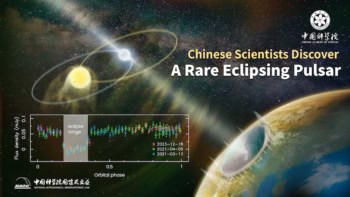
A debris disc just discovered around a nearby star bears an uncanny resemblance to a young version of our solar system’s Kuiper belt, according to an international team of astronomers. This extrasolar disc shares many similarities with our ring, and it could be the key to better understanding the interactions between debris discs and planets, as well as how our solar system evolved early in its lifetime.
Analogue rings
The Kuiper belt is a ring of icy and dusty debris that lies just beyond Neptune’s orbit, and it is home to Pluto, several other known dwarf planets, and thousands of other remnants of the early stages of icy-planet formation in our solar system.
Understanding how this disc was formed, and how it gained its current structure and composition, is crucial to understanding the birth and evolution of our solar system. The best way to do so would be to witness a similar debris disc in an earlier stage of its life. Until now, astronomers had discovered several other discs around nearby stars but none of the systems were similar to our own: the rings are typically too large, the central star too massive, or the stars exist in regions very unlike what we think our Sun’s birthplace was like. Furthermore, the observations made of these discs were limited in their quality, and they did not include spatially resolved spectra that could provide clues about the composition of the discs.
Now, though, a team of astronomers led by Thayne Currie from the University of Toronto in Canada and the National Astronomical Observatory of Japan has changed this using the Gemini Planet Imager (GPI), an instrument on the Gemini South Telescope located in Chile. The researchers discovered a debris disc of roughly the same size as the Kuiper belt orbiting the star HD 115600, which is located a mere 360 light-years from Earth. The star is only slightly more massive than our Sun, and sits in a star-forming region similar to that in which we believe the Sun was born. But HD 115600 is different in one key way – it is only 15 million years old, compared with our Sun’s age of 4.6 billion years. This means that observing it gives us the perfect opportunity to see how our solar system might have behaved when it was much younger.
“To be able to directly image planetary-birth environments around other stars at orbital distances comparable to the solar system is a major advancement,” says team member Nikku Madhusudhan of the University of Cambridge in the UK. “Our discovery of a near-twin of the Kuiper belt provides direct evidence that the planetary-birth environment of the solar system may not be uncommon.”
This spectroscopy, combined with measurements of the reflectivity of the disc, has led the team to suspect that the disc might be composed partly of water ice, just like our own Kuiper belt. The disc also shows evidence of having been sculpted by the motions of giant planets orbiting the central star, in much the same way that the outer planets in our solar system may have shaped the Kuiper belt.
Next-generation planet hunters
This discovery has been made possible thanks to the new generation of extreme adaptive-optics systems, such as those used on the GPI, in which the optics actively correct – in real time – for the distortion caused by effects such as atmospheric turbulence. This results in images with reduced glare and higher levels of sharpness than were previously possible at the same wavelengths. “In about 50 seconds of exposure time on GPI, we can see things (like this debris ring) that we cannot see in 50 minutes of time with conventional systems,” Currie explains. The GPI also boasts another unique advantage – it records spatially resolved spectra while it images, thus giving astronomers additional information about the dust in the disc, such as its composition.
The research will be published next month in Astrophysical Journal Letters. A preprint is available on arXiv.



